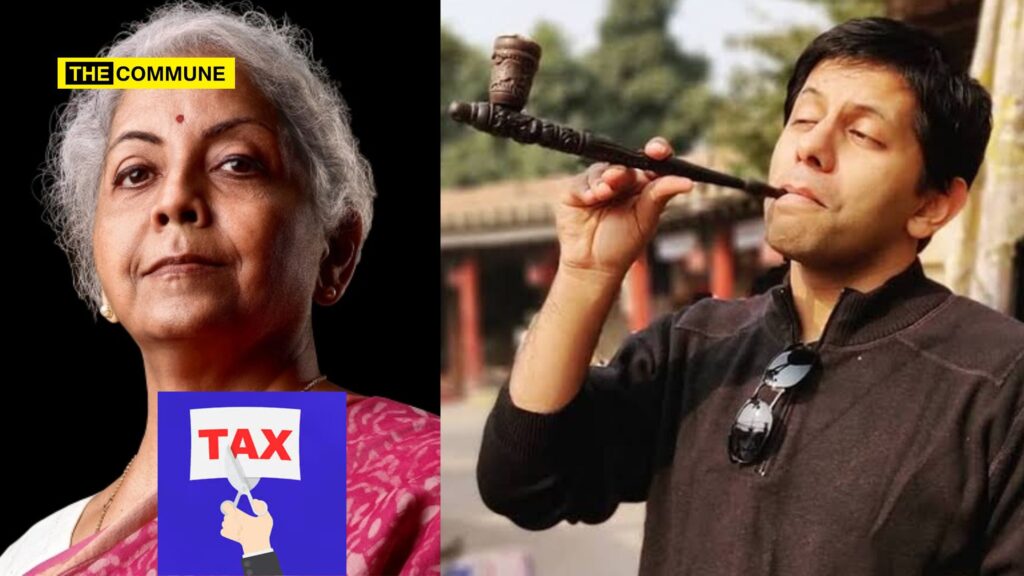With the Budget 2025 just announced, several taxpayers are rejoicing, especially the middle class, after Union Finance Minister Nirmala Sitharaman announced that there will be no tax for individuals earning up to ₹12 lakh under the new regime.
However, propagandists like The Deshbhakt’s Akash Banerjee had to do something about this good news for the public and twist it in order to create a fake narrative.
In his video titled “Bold or Band-Aid? | Will Nirmala Sitaraman’s Budget Help India’s Economy Recover?”, he mocks the PM, FM, and even Goddess Lakshmi.
Coming to the main part of his fake news video, he talks about the zero tax for those earning up to 12 lakhs. He says, “If you are earning Rs. 12 lakhs in a year, you don’t need to pay any tax. You need to be salaried. There is fine print for this as well. There are ifs and buts. But, in simple terms, you pay nil tax on 12 lakhs If you are earning 12 lakhs in a year, then you are paying 0 for the first 4 lakhs. Between 4 lakhs and 8 lakhs, for the next 4 lakhs, you are paying a 5% tax Between 8 lakhs and 12 lakhs, the remaining 4 lakhs you earn, you will have to pay a tax of 10%. Total tax is payable. ₹60,000. But now, a standard deduction has been made of ₹75,000.”
He continues, “So, effectively, the post-tax rebate that you get, your income should be ₹12 lakh or technically ₹12.75 lakh – tax slabs have not changed. The rebate has changed. This means that if your salary is ₹12.76 lakhs, then you will have to pay almost the same tax, which would increase your tax liability for those earning ₹12 lakhs salary. So, whoever is earning up to ₹1 lakh is happy. Whoever earns more than ₹1 lakh is sad.”
As expected, the IQ level of such propagandists is way below the national average. Banerjee does not know the economics or maths of this calculation and also has no idea about what is known as “marginal relief.”
Let’s dive in.
Understanding Marginal Tax Relief For Salaries Just Above ₹12 Lakh
For individuals earning just over ₹12 lakh, marginal tax relief ensures they are not disproportionately taxed. Without this relief, a person with a taxable salary of ₹12,10,000 would owe ₹61,500 in taxes, while someone earning ₹12 lakh or less would pay nothing.
Marginal relief ensures that those earning slightly above the tax-free threshold are not unfairly taxed. Instead of paying the full tax amount, they pay only the difference between their taxable income and ₹12 lakh.
For instance, an individual earning ₹12,10,000 would pay ₹10,000 in taxes rather than the full ₹61,500. This relief is available for incomes up to ₹12.75 lakh per year.
Salaried individuals benefit from a ₹75,000 standard deduction, effectively making annual earnings up to ₹12.75 lakh tax-free.
Here are some examples:
Income: ₹12,10,000
-
- Tax without marginal relief: ₹61,500
- Actual tax due: ₹10,000
- Savings due to marginal relief: ₹51,500
Income: ₹12,50,000
-
- Tax without marginal relief: ₹67,500
- Actual tax due: ₹50,000
- Savings due to marginal relief: ₹17,500
Income: ₹12,70,000
-
- Tax without marginal relief: ₹70,500
- Actual tax due: ₹70,000
- Savings due to marginal relief: ₹500
Income: ₹12,75,000
-
- Tax due: ₹71,250
- No marginal relief applicable
Marginal tax relief prevents sudden tax burdens for those earning slightly above ₹12 lakh. It ensures a gradual tax increase, preventing unfair deductions. However, once income exceeds ₹12.75 lakh, the full tax rate applies without relief.
The likes of Akash Banerjee can do themselves some good and gain some general knowledge if they do just a cursory goGoogleearch instead of spreading lies and causing panic and chaos among the public.
(With inputs from The Economic Times)
Subscribe to our channels on Telegram, WhatsApp, and Instagram and get the best stories of the day delivered to you personally.

